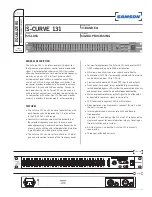
Servers
Setting initial Weights for Mixed Clusters
Equalizer enables you to build heterogeneous clusters using servers of widely varying capabilities.
Adjust for the differences by assigning initial weights that correspond to the relative capabilities
of the available servers. This enables you to get the most out of existing hardware, so you can use
an older server side-by-side with a new one.
After you assign relative initial weights, monitor cluster performance for two to three hours under
load. You will probably fine-tune the weights and optimize performance of your cluster two or
three times.
Continue monitoring the performance of your cluster and servers and watch for any trends. For
example, if you notice that Equalizer
always
adjusts the dynamic weights so that the weight of
one server is far below 100 and the weight of another is far above 100, the server whose dynamic
weight is consistently being reduced might have a problem.
Interaction of Server Options and Connection Processing
Server option settings have a direct influence on connection and request processing, particularly
Layer 4 and Layer 7 persistence. (Note that persistence is set at the cluster level, but can be
disabled for individual servers using the
Dont Persist
option.) The hierarchy of server option
settings is shown in the table below:
Server disabled
An
initial weight
of
0
tells Equalizer that no traffic should be sent to the
server, disabling the server. This option setting takes precedence over all
other options (including persistence, hot spare, etc.).
Max Connections (> 0)
If set to a non-zero value, Equalizer limits the total number of sim-
ultaneously open connections to the server to that value. This limit is not
overridden if the
Hot Spare
option is enabled on a server, and is not over-
ridden by a Layer 4 sticky record or Layer 7 persistence cookie for the
server in an incoming request.
Quiesce Enabled
The server is
not
included in load balancing decisions, so that no
new
con-
nections will be made to this server. If a request in an incoming connection
has an existing Layer 4 sticky record or Layer 7 cookie for a server, how-
ever, the request will be sent to that server even when
Quiesce
is
enabled.
If
dont persist
is also enabled on the server, the sticky record or cookie is
ignored.
Hot Spare Enabled
The server is
not
included in load balancing decisions, so that traffic is
sent to this server
only
when no other server in the cluster is available to
accept client connections. If a request in an incoming connection has an
existing Layer 4 sticky record or Layer 7 cookie for a server, however, the
request will be sent to that server even when
hot spare
is enabled.
If
dont persist
is also enabled on the server, the sticky record or cookie is
ignored.
Shutting Down a Server Gracefully
466
Copyright © 2014 Coyote Point Systems, A Subsidiary of Fortinet, Inc.
Summary of Contents for Equalizer GX Series
Page 18: ......
Page 32: ...Overview 32 Copyright 2014 Coyote Point Systems A Subsidiary of Fortinet Inc ...
Page 42: ......
Page 52: ......
Page 64: ......
Page 72: ......
Page 76: ......
Page 228: ......
Page 238: ......
Page 476: ......
Page 492: ......
Page 530: ......
Page 614: ......
Page 626: ......
Page 638: ......
Page 678: ......
Page 732: ...Using SNMP Traps 732 Copyright 2014 Coyote Point Systems A Subsidiary of Fortinet Inc ...
Page 754: ......
Page 790: ......
Page 804: ......
Page 842: ......
Page 866: ......
















































